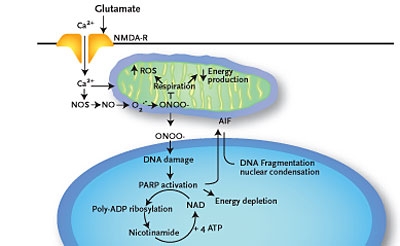Fig 1.

Glutamate increases Ca2+ cellular influx, activating neuronal nitric oxide–synthetase (nNOS); this enzyme, in the presence of Ca2+ absorbed at mitochondria level, converts nitric oxide (NO) in peroxinitrite (ONOO– ): one of the most toxic ORS; Ca2+ and ONOO–, apparently paradoxical, blocks the mitochondrial breathing (in terms of oxidative metabolic hyperactivity, which is induced by Ca2+); concomitantly/ consequently, at the respiratory chain level, increases the production of ROS. It results: energetical mitochondrial collapse, damaging (predominantly by peroxidation) the membranar lipids – with propensive permeabilisation getting out from mitochondrias and translocating to the nucleus of AIF – and DNA by ROS (mainly ONOO–) and respectively, secondary hiperactivation of poly–ADP–ribozo– polymerase (PARP) –1 enzyme; the latter convey the signals of cell suicide by engramated, preformated way on nuclear level, through chemical–energetical revolving plate's depletion, represented by nicotine–amide– dinucleotide (NAD)+/ATP, resulting a proapoptotic effect, synergically in such cases, with the one of Endonuclease G (Endo G) – after Hong cited by Blackman S A, 2005 [1,3]
